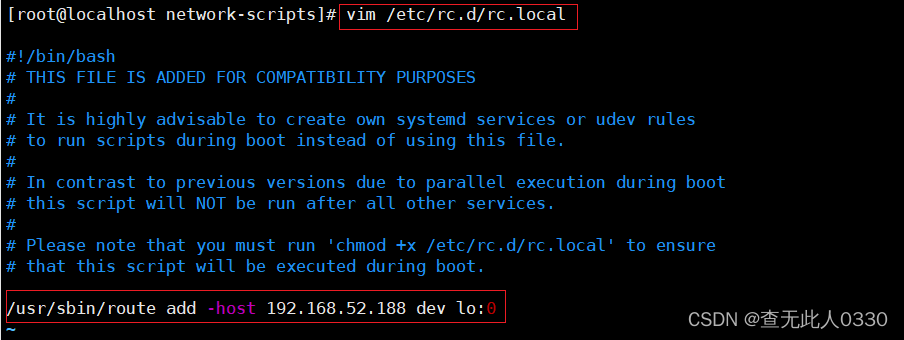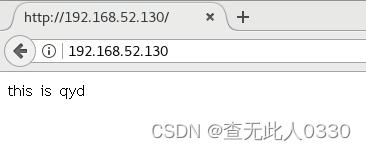目录
1、数据包流向分析
(1)客户端发送请求到Director Server(负载均衡器),请求的数据报文(源IP是CIP,目标IP 是VIP)到达内核空间。
(2)Director server 和 Real Server在同一个网络中,数据通过二层数据链路层来传输。
(3)内核空间判断数据包的目标IP是本机VIP,此时IPVS(IP虚拟服务器)比对数据包请求的服务是否是集群服务,是集群服务就重新封装数据包。修改源MAc地址为 Director Server的MAC地址,修改目标MAC地址为Real Server 的MAC地址,源IP 地址与目标IP地址没有改变,然后将数据包发送给Real server。
(4)到达Real Server的请求报文的NAc 地址是自身的wAc 地址,就接收此报文。数据包重新封装报文(源ⅠP地址为VIP,目标 IP 为CIP),将响应报文通过lo 接口传送给物理网卡然后向外发出。
(5) Real server直接将l响应报文传送到客户端。
2、DR 模式的特点:
(1) Director server 和 Real Server必须在同一个物理网络中。
(2)Real Server 可以使用私有地址,也可以使用公网地址。如果使用公网地址,可以通过互联网对RIP进行直接访问。
(3) Director Server作为群集的访问入口,但不作为网关使用。
(4)所有的请求报文经由 Director Server,但回复响应报文不能经过 Director Server
(5) Real Server的网关不允许指向 Director Server IP,即Real Server发送的数据包不允许经过Director Server
(6) Real server 上的lo接口配置VIP的IP地址。
3、LVS-DR中的ARP问题
IP地址冲突
在LVS-DR负载均衡集群中,负载均衡器与节点服务器都要配置相同的VIP地址,在局域网中具有相同的IP地址。在局域网中具有相同的地址,势必会造成各服务器ARP通信的紊乱
- 当ARP广播发送到LVS-DR集群时,因为负载均衡器和节点服务器都是连接到相同的网络上,它们都会接收到ARP广播
- 只有前端的负载均衡器器进行响应,其他节点服务器不应该响应ARP广播
解决办法
对节点服务器进行处理,使其不响应VIP的ARP请求
- 用虚接口lo:0承载VIP地址
- 设置内核参数arp_ ignore=1: 系统只响应目的IP为本地IP的ARP请求
设置完后节点服务器则不会去响应ARP广播,而调度器则仍然会响应ARP所以只能解析到调度器的MAC地址
路由根据ARP表项,会将新来的请求报文转发给RealServer,导致Director的VIP失效
- RealServer返回报文(源IP是VIP)经路由器转发,重新封装报文时,需要先获取路由器的MAC地址,
- 发送ARP请求时,Linux默认使用IP包的源IP地址(即VIP)作为ARP请求包中的源IP地址,而不使用发送接口的IP地址,
- 路由器收到ARP请求后,将更新ARP表项,原有的VIP对应Director的MAC地址会被更新为VIP对应RealServer的MAC地址。
- 路由器根据ARP表项,会将新来的请求报文转发给RealServer,导致Director的VIP失效
解决方法
对节点服务器进行处理
- 设置内核参数arp_announce=2
- 系统不使用IP包的源地址来设置ARP请求的源地址,而选择发送接口的IP地址
两个问题的设置方法
修改/etc/sysctl.conf文件
节点服务器在lo:0虚接口上承载VIP地址
net.ipv4.conf.lo.arp_ignore = 1 #使本机系统只响应目的IP为本地物理网卡IP的ARP请求
net.ipv4.conf.lo.arp_announce = 2 #本机系统不使用返回数据包的源地址作为ARP请求报文的源地址,而采用发送接口的IP作为ARP请求报文源地址
net.ipv4.conf.all.arp_ignore = 1
net.ipv4.conf.all.arp_announce = 24、部署DR模式
调度服务器192.168.52.140
NFS服务器192.168.52.110
web1服务器192.168.52.120
web2服务器192.168.52.130
客户端192.168.52.102
VIP192.168.52.188
192168.52.140调度服务器
关闭防火墙与selinux,下载ipvsadm
[root@localhost ~]# systemctl stop firewalld.service
[root@localhost ~]# setenforce 0
[root@localhost ~]# yum install ipvsadm -y
配置虚拟IP地址
[root@localhost network-scripts]# ls
ifcfg-ens33 ifdown-ippp ifdown-sit ifup-bnep ifup-plip ifup-Team network-functions-ipv6
ifcfg-lo ifdown-ipv6 ifdown-Team ifup-eth ifup-plusb ifup-TeamPort
ifdown ifdown-isdn ifdown-TeamPort ifup-ib ifup-post ifup-tunnel
ifdown-bnep ifdown-post ifdown-tunnel ifup-ippp ifup-ppp ifup-wireless
ifdown-eth ifdown-ppp ifup ifup-ipv6 ifup-routes init.ipv6-global
ifdown-ib ifdown-routes ifup-aliases ifup-isdn ifup-sit network-functions
[root@localhost network-scripts]# cp ifcfg-ens33 ifcfg-ens33:0
[root@localhost network-scripts]# vim ifcfg-ens33:0
DEVICE=ens33:0
ONBOOT=yes
IPADDR=192.168.52.188
NETMASK=255.255.255.0
#GATEWAY=192.168.52.2
#DNS1=8.8.8.8
重启网卡
[root@localhost network-scripts]# ifdown ifcfg-ens33:0
[root@localhost network-scripts]# ifup ifcfg-ens33:0
调整proc响应参数
[root@localhost network-scripts]# vim /etc/sysctl.conf
net.ipv4.ip_forward = 0
net.ipv4.conf.all.send_redirects = 0
net.ipv4.conf.default.send_redirects = 0
net.ipv4.conf.ens33.send_redirects = 0
刷新配置
[root@localhost network-scripts]# sysctl -p
net.ipv4.ip_forward = 0
net.ipv4.conf.all.send_redirects = 0
net.ipv4.conf.default.send_redirects = 0
net.ipv4.conf.ens33.send_redirects = 0
加载模块
[root@localhost network-scripts]# modprobe ip_vs
[root@localhost network-scripts]# cat /proc/net/ip_vs
IP Virtual Server version 1.2.1 (size=4096)
Prot LocalAddress:Port Scheduler Flags
-> RemoteAddress:Port Forward Weight ActiveConn InActConn
配置负载分配策略,启动服务
[root@localhost network-scripts]# ipvsadm-save >/etc/sysconfig/ipvsadm
[root@localhost network-scripts]# systemctl start ipvsadm.service
清空ipvsadm
[root@localhost network-scripts]# ipvsadm -C
添加策略
[root@localhost network-scripts]# ipvsadm -A -t 192.168.52.188:80 -s rr
[root@localhost network-scripts]# ipvsadm -a -t 192.168.52.188:80 -r 192.168.52.120:80 -g
[root@localhost network-scripts]# ipvsadm -a -t 192.168.52.188:80 -r 192.168.52.130:80 -g
保存设置
[root@localhost network-scripts]# ipvsadm
IP Virtual Server version 1.2.1 (size=4096)
Prot LocalAddress:Port Scheduler Flags
-> RemoteAddress:Port Forward Weight ActiveConn InActConn
TCP localhost.localdomain:http rr
-> 192.168.52.120:http Route 1 0 0
-> 192.168.52.130:http Route 1 0 0
[root@localhost network-scripts]# ipvsadm -ln
IP Virtual Server version 1.2.1 (size=4096)
Prot LocalAddress:Port Scheduler Flags
-> RemoteAddress:Port Forward Weight ActiveConn InActConn
TCP 192.168.52.188:80 rr
-> 192.168.52.120:80 Route 1 0 0
-> 192.168.52.130:80 Route 1 0 0
[root@localhost network-scripts]# ipvsadm-save >/etc/sysconfig/ipvsadm192.168.52.110NFS服务器
[root@localhost ~]# cd /opt/
[root@localhost opt]# ls
rh
[root@localhost opt]# mkdir nfs
[root@localhost opt]# cd nfs/
[root@localhost nfs]# mkdir my qyd
[root@localhost nfs]# ls
my qyd
[root@localhost nfs]# echo "this is my" >my/index.html
[root@localhost nfs]# echo "this is qyd" >qyd/index.html
[root@localhost nfs]#
设置权限
[root@localhost nfs]# chmod 777 *
[root@localhost nfs]# ll
总用量 0
drwxrwxrwx. 2 root root 24 5月 13 16:30 my
drwxrwxrwx. 2 root root 24 5月 13 16:30 qyd
设置共享策略
[root@localhost nfs]# vim /etc/exports
/opt/nfs/my 192.168.52.0/24(rw,sync,no_root_squash)
/opt/nfs/qyd 192.168.52.0/24(rw,sync,no_root_squash)
开启服务发布共享
[root@localhost nfs]# systemctl start rpcbind
[root@localhost nfs]# systemctl start nfs
[root@localhost nfs]# showmount -e
Export list for localhost.localdomain:
/opt/nginx/qyd 192.168.52.0/24
/opt/nginx/my 192.168.52.0/24192.168.52.120web1服务器
关闭防火墙
[root@localhost ~]# systemctl stop firewalld.service
[root@localhost ~]# setenforce 0
[root@localhost ~]# showmount -e 192.168.52.110
Export list for 192.168.52.110:
/opt/nfs/qyd 192.168.52.0/24
/opt/nfs/my 192.168.52.0/24安装apache服务
[root@localhost ~]# yum install httpd -y挂载
[root@localhost ~]# mount 192.168.52.110:/opt/nfs/my /var/www/html/
[root@localhost ~]# df -h
文件系统 容量 已用 可用 已用% 挂载点
/dev/mapper/centos-root 20G 3.7G 17G 19% /
devtmpfs 473M 0 473M 0% /dev
tmpfs 489M 0 489M 0% /dev/shm
tmpfs 489M 7.2M 481M 2% /run
tmpfs 489M 0 489M 0% /sys/fs/cgroup
/dev/sda1 1014M 161M 854M 16% /boot
tmpfs 98M 0 98M 0% /run/user/0
tmpfs 98M 12K 98M 1% /run/user/42
192.168.52.110:/opt/nfs/my 10G 3.7G 6.4G 37% /var/www/html
[root@localhost ~]# cd /var/www/html/
[root@localhost html]# ls
index.html
[root@localhost html]# cat index.html
this is my
重启服务并输入IP地址查看
[root@localhost html]# systemctl restart httpd.service 配置网关
重启网卡
[root@localhost network-scripts]# systemctl restart network
[root@localhost network-scripts]# ifconfig设置路由
[root@localhost network-scripts]# route add -host 192.168.52.188 dev lo:0
[root@localhost network-scripts]# route -n
Kernel IP routing table
Destination Gateway Genmask Flags Metric Ref Use Iface
0.0.0.0 192.168.52.2 0.0.0.0 UG 100 0 0 ens33
192.168.52.0 0.0.0.0 255.255.255.0 U 100 0 0 ens33
192.168.52.188 0.0.0.0 255.255.255.255 UH 0 0 0 lo
192.168.122.0 0.0.0.0 255.255.255.0 U 0 0 0 virbr0
开机执行命令
[root@localhost network-scripts]# vim /etc/rc.d/rc.local
#!/bin/bash
# THIS FILE IS ADDED FOR COMPATIBILITY PURPOSES
#
# It is highly advisable to create own systemd services or udev rules
# to run scripts during boot instead of using this file.
#
/usr/sbin/route add -host 192.168.52.188 dev lo:0
[root@localhost network-scripts]# chmod +x /etc/rc.d/rc.local
调整proc响应参数
[root@localhost network-scripts]# vim /etc/sysctl.conf
# sysctl settings are defined through files in
# /usr/lib/sysctl.d/, /run/sysctl.d/, and /etc/sysctl.d/.
#
# Vendors settings live in /usr/lib/sysctl.d/.
# To override a whole file, create a new file with the same in
# /etc/sysctl.d/ and put new settings there. To override
# only specific settings, add a file with a lexically later
# name in /etc/sysctl.d/ and put new settings there.
#
# For more information, see sysctl.conf(5) and sysctl.d(5).
net.ipv4.conf.all.arp_ignore = 1
net.ipv4.conf.all.arp_announce = 2
net.ipv4.conf.default.arp_ignore = 1
net.ipv4.conf.default.arp_announce = 2
net.ipv4.conf.lo.arp_ignore = 1
net.ipv4.conf.lo.arp_announce = 2
[root@localhost network-scripts]# sysctl -p
net.ipv4.conf.all.arp_ignore = 1
net.ipv4.conf.all.arp_announce = 2
net.ipv4.conf.default.arp_ignore = 1
net.ipv4.conf.default.arp_announce = 2
net.ipv4.conf.lo.arp_ignore = 1
net.ipv4.conf.lo.arp_announce = 2
192.168.52.130web2服务器
关闭防火墙
[root@localhost ~]# systemctl stop firewalld.service
[root@localhost ~]# setenforce 0
[root@localhost ~]# showmount -e 192.168.52.110
Export list for 192.168.52.110:
/opt/nfs/qyd 192.168.52.0/24
/opt/nfs/my 192.168.52.0/24安装apache服务
[root@localhost ~]# yum install httpd -y挂载
[root@localhost ~]# mount 192.168.52.110:/opt/nfs/qyd /var/www/html/
[root@localhost ~]# df -h
文件系统 容量 已用 可用 已用% 挂载点
/dev/mapper/centos-root 15G 3.7G 12G 25% /
devtmpfs 897M 0 897M 0% /dev
tmpfs 912M 0 912M 0% /dev/shm
tmpfs 912M 9.1M 903M 1% /run
tmpfs 912M 0 912M 0% /sys/fs/cgroup
/dev/sda1 497M 172M 326M 35% /boot
tmpfs 183M 4.0K 183M 1% /run/user/42
tmpfs 183M 44K 183M 1% /run/user/0
192.168.52.110:/opt/nfs/qyd 10G 3.7G 6.4G 37% /var/www/html
[root@localhost ~]# cd /var/www/html/
[root@localhost html]# ls
index.html
[root@localhost html]# cat index.html
this is qyd
重启服务并输入IP地址查看
[root@localhost html]# systemctl restart httpd.service 配置网关
[root@localhost html]# cd /etc/sysconfig/network-scripts/
[root@localhost network-scripts]# ls
ifcfg-ens33 ifdown-ipv6 ifdown-TeamPort ifup-ippp ifup-routes network-functions
ifcfg-lo ifdown-isdn ifdown-tunnel ifup-ipv6 ifup-sit network-functions-ipv6
ifdown ifdown-post ifup ifup-isdn ifup-Team
ifdown-bnep ifdown-ppp ifup-aliases ifup-plip ifup-TeamPort
ifdown-eth ifdown-routes ifup-bnep ifup-plusb ifup-tunnel
ifdown-ib ifdown-sit ifup-eth ifup-post ifup-wireless
ifdown-ippp ifdown-Team ifup-ib ifup-ppp init.ipv6-global
[root@localhost network-scripts]# cp ifcfg-lo ifcfg-lo:0
[root@localhost network-scripts]# vim ifcfg-lo:0
DEVICE=lo:0
IPADDR=192.168.52.118
NETMASK=255.255.255.255
重启服务并查看
[root@localhost network-scripts]# systemctl restart network
[root@localhost network-scripts]# ifconfig
设置路由
[root@localhost network-scripts]# route add -host 192.168.52.188 dev lo:0
[root@localhost network-scripts]# route -n
Kernel IP routing table
Destination Gateway Genmask Flags Metric Ref Use Iface
0.0.0.0 192.168.52.2 0.0.0.0 UG 100 0 0 ens33
192.168.52.0 0.0.0.0 255.255.255.0 U 100 0 0 ens33
192.168.52.188 0.0.0.0 255.255.255.255 UH 0 0 0 lo
192.168.122.0 0.0.0.0 255.255.255.0 U 0 0 0 virbr0
开机执行命令
[root@localhost network-scripts]# vim /etc/rc.d/rc.local
#!/bin/bash
# THIS FILE IS ADDED FOR COMPATIBILITY PURPOSES
#
# It is highly advisable to create own systemd services or udev rules
# to run scripts during boot instead of using this file.
#
/usr/sbin/route add -host 192.168.52.188 dev lo:0
[root@localhost network-scripts]# chmod +x /etc/rc.d/rc.local
调整proc响应参数
[root@localhost network-scripts]# vim /etc/sysctl.conf
# sysctl settings are defined through files in
# /usr/lib/sysctl.d/, /run/sysctl.d/, and /etc/sysctl.d/.
#
# Vendors settings live in /usr/lib/sysctl.d/.
# To override a whole file, create a new file with the same in
# /etc/sysctl.d/ and put new settings there. To override
# only specific settings, add a file with a lexically later
# name in /etc/sysctl.d/ and put new settings there.
#
# For more information, see sysctl.conf(5) and sysctl.d(5).
net.ipv4.conf.all.arp_ignore = 1
net.ipv4.conf.all.arp_announce = 2
net.ipv4.conf.default.arp_ignore = 1
net.ipv4.conf.default.arp_announce = 2
net.ipv4.conf.lo.arp_ignore = 1
net.ipv4.conf.lo.arp_announce = 2
[root@localhost network-scripts]# sysctl -p
net.ipv4.conf.all.arp_ignore = 1
net.ipv4.conf.all.arp_announce = 2
net.ipv4.conf.default.arp_ignore = 1
net.ipv4.conf.default.arp_announce = 2
net.ipv4.conf.lo.arp_ignore = 1
net.ipv4.conf.lo.arp_announce = 2
客户机测试192.168.52.102
浏览器输入回环lo:0VIP地址:192.168.52.188



























